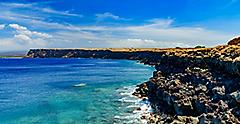Where To Go Cliff Jumping For The Ultimate Adventure Vacation
Discover the Best Cliff Jumping Spots at these Iconic Destinations.
By Chantae Reden | Published on June 3, 2025
I gazed down at my feet, which were planted firmly on the edge of a cliff on Ka Lae, the southernmost point of Hawaii. I had heard tales of cliff jumping, where Hawaii travelers tried everything from cliff jumping in Oahu’s famed spots to plunging into the waters of distant Kauai, but experiencing the thrill in person was more exhilarating than I could have anticipated. My eyes drifted ahead to the dark teal waters of the Pacific Ocean, where a dark shape of schooling fish morphed into a sphere in the distance, reminding me of how unbound and vast the ocean truly is. A line of bathing-suit-clad thrill-seekers eager to go cliff jumping snaked behind me, waiting to hurl themselves off the safety of terra firma and into the depths below. Though some might wonder, “Is cliff jumping dangerous?” careful preparation and respect for local conditions make it a truly unforgettable experience.
"On the count of three, just send it." My friend commanded.
I nodded.
"One … "
"Two … "
I closed my eyes and leaped. For a moment, I was free-falling between land and sea, in a place where worries couldn't reach me. The cool sensation on my skin as I hit the water gave me energy. Hair tangled, swimsuit askew, and skin covered in goosebumps, I clamored up the cliff to join the queue and jump againEven though I'd heard of the Waimea Bay cliff jump back on Oahu, this moment was my personal introduction to the adrenaline rush of cliff jumping in Hawaii.
If your sense of wonder has been stirred by the idea of jumping off a cliff, come along as I dive into the history of the sport, the best places in the world to try it on an adventure vacation, and some tips for jumping safely.
Whether you seek the highest cliff jumping spots or simply a short drop into turquoise water, you've got plenty of options around the globe. Continue reading to learn about some of the best cliff jumping spots around the globe, as well as the history behind this activity and how to stay safe while cliff diving.
The History Of The Thrill

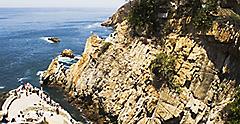
The Best Places To Cliff Jump Around The World
Cliff Jumping In Hawaii

There's no shortage of excellent jumping spots around the islands of Hawaii, though some are more famous than others. When traveling in Oahu, signs warn tourists not to jump off the rock at Waimea Bay, though it's rare to see the rock without cliff jumpers on a calm day during high tide. This famous Waimea Bay cliff jump can be a mesmerizing sight for onlookers, evidence of how strong the lure of cliff jumping in Oahu truly is. Laie Point is another scenic spot — featured in the rom-com "Forgetting Sarah Marshall" — where you can leap from 20 feet into aquarium -clear water below.
Elsewhere, Maui's Kaanapali Beach hosts a cliff of lava where jumps can be adapted to height preference, offering a taste of what cliff diving in Maui thrills are all about. On Hawaii Island, you can jump from the southernmost point in the archipelago at Ka Lae or into the cool pool of Kapena Falls. Some travelers even venture further to explore cliff jumping in Kauai’s picturesque landscapes, discovering hidden gems along unspoiled coastlines.
Cliff Jumping In The Bahamas
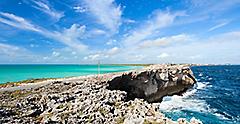
With over 700 islands and 2,400 cays within its borders, The Bahamas is an ocean adventure paradise. Eleuthera is the most popular island for cliff jumping, where limestone cliffs jutting 40 feet over the ocean offer prime potential at Glass Window Bridge. Or, for the less experienced, leap from the 20-foot jump point near Rainbow Bay.
It might not be as high as some of the highest cliff jumping areas in the world, but it’s still enough to give you a true adrenaline rush.
Cliff Jumping In Jamaica
Cliff Jumping In Mexico

When vacationing in Mexico, you will see that it holds no shortage of spots to go cliff diving in Mexico. If you want to witness some of the world's best cliff divers twirl and flip with precision, admire the divers of Acapulco, who dive from cliffs over 130 feet high. Mexican cliff diving has a long history, rooted in tradition and applauded by tourists from around the globe. The skyscraping cliffs of Mazatlan and the iconic arch of Cabo San Lucas are also best left to the professionals, though you may find brave souls attempting Cabo cliff jumping on calmer days.
To jump yourself, venture to the Yucatan region where over 6,000 cenotes await. Limestone ledges and platforms throughout this lush, vine-laden landscape — like the cenotes of Ik Kil, Dos Ojos, Cristalino and Jardin del Eden — are idyllic places to dive and relax.
Cliff Jumping In Portugal
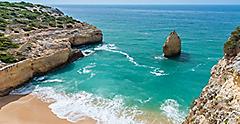
As you visit Portugal, you may want to take note of the intriguing cliffs of the Algarve, notably at Praia do Carvalho, which are rife with arches and caves, prime for jumping off. Thrills can also be found near Lisbon in Arrabida National Park and in lesser-known spots of the remote Azores islands, where the guidance of a local is essential.
Although you won’t find as many famed jump sites as in cliff jumping Hawaii hotspots, the dramatic coastline of Portugal is still beloved by many, for those who wish to explore more in the Caribbean.
Pull Quote: Cliff jumping is one of the best ways to feel unbound freedom as you travel. The sheer act of it forces you to be keenly aware of your surroundings, urges you to live in the moment, and gives you confidence in yourself.
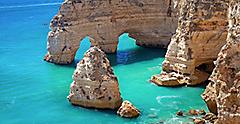
How Risky Is Cliff Diving?
Like any adventure vacation activity, cliff jumping is inherently risky, and injury is possible even when you take precautions. However, there are many ways to lower your risk so long as you keep a sharp sense of your surroundings and only jump at spots suitable for your skill level.
Here are the main dangers you should watch out for when cliff jumping:
Diving Alone or in a Quiet Spot
It's safest to go with a guide or local who knows the cliff jump area well. If you don't have a guide, it's best to jump where there's already an active scene rather than finding a launch point for yourself. Local cliff jumpers will tell you where to jump from, if you need to be aware of any tree branches or rocky points to clear, and how to get out of the water. Jumping with a friend means you'll have someone to help you should anything happen.
For this reason, many choose popular sites like the Waimea Bay cliff jump, Rick's Cafe cliff jump height vantage point or other well-known areas with supervision.
Lack of Physical Strength
Some spots require cliff jumpers to rock climb, use a rope ladder, or swim a long distance to get to dry land, which could take more strength than expected.
Mastering these physical demands will help keep the experience fun and safe.
Bad Weather and Ocean Conditions
Most ocean cliff jump spots are only safe to explore during calm days when there are no ocean swells, currents, wind, tides and rain to contend with. Only jump over deep, clear, calm water, and check for debris or submerged rocks below before you commit. Wear lightweight clothes, ideally swimwear, that won't weigh you down once you get wet. Reef booties are a good idea at jump spots with sharp rocks and ledges.
Whether you’re checking out cliff jumping in Maui or heading to smaller local ledges, the same caution applies.
Poor Jumping Form
Once you take the leap, stay as upright as possible and keep your legs closed. The smaller the surface area you have to hit the water, the more comfortable the jump will be. Rotate too far forward or backward and you'll be heading home with pink skin courtesy of a painful flop. That’s especially true if you’re attempting one of the highest cliff jumping options in your area.
Start Your Cliff Jumping Adventure
Cliff jumping is one of the best ways to feel unbound freedom as you travel. The sheer act of it forces you to be keenly aware of your surroundings, urges you to live in the moment and gives you confidence in yourself.
I've spent years trying to tame my fear of falling. I've bungee-jumped from a bridge over the Zambezi River, skydived over the wild coastline of San Diego in California, and jumped from tens of cliffs around the world. I hope to never conquer the fear completely, as it's an essential ingredient in the excitement of it all.
Ready to test the waters of cliff diving? Explore Royal Caribbean’s cruise destinations with the best and highest cliff jumping spots to take on this thrill for yourself.
